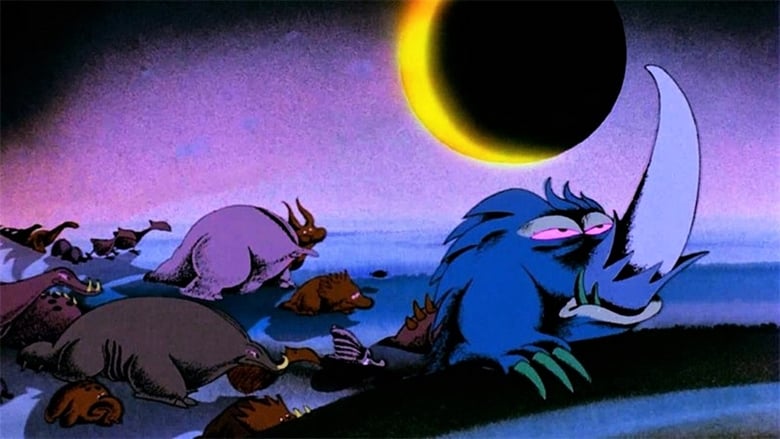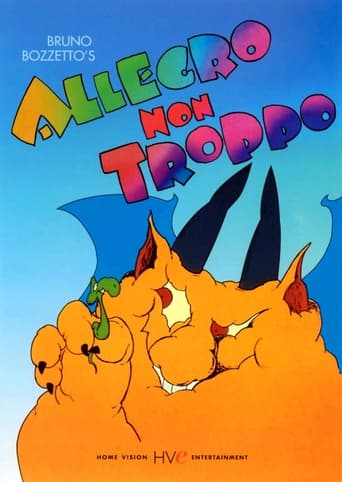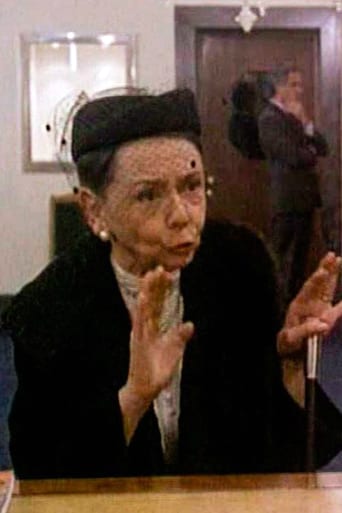The film is a parody of Disney's Fantasia, though possibly more of a challenge to Fantasia than parody status would imply. In the context of this film, "Allegro non Troppo" means Not So Fast!, an interjection meaning "slow down" or "think before you act" and refers to the film's pessimistic view of Western progress (as opposed to the optimism of Disney's original).
Similar titles

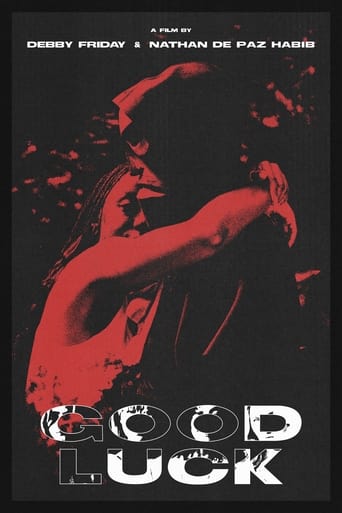
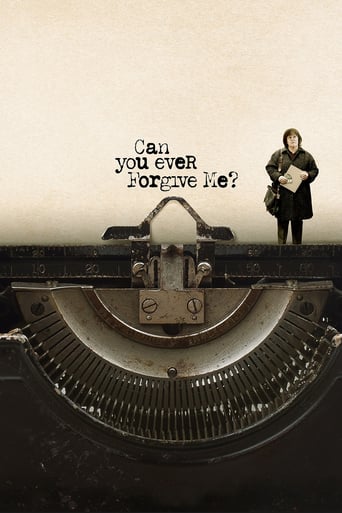
Reviews
best movie i've ever seen.
It’s sentimental, ridiculously long and only occasionally funny
An old-fashioned movie made with new-fashioned finesse.
All of these films share one commonality, that being a kind of emotional center that humanizes a cast of monsters.
We all remember Disney's Fantasia as a beautifully crafted visual masterpiece that presented gorgeous imagery in tuned to classical music scores. From Mickey Mouse as a sorcerer's apprentice, to the evolution of life in The Rite of Spring, to the legendary Night on Bald Mountain, Fantasia is forever regarded as one of the greatest films of all time for how technically innovative and haunting it is. As for today's film, Allegro non troppo comes from the creatively humorous mind of beloved Italian animator Bruno Bozzeto and his team of animators as a clever parody and tribute to the classic, and it delivers in flying colors.The film is a collection of six animated shorts (two of which actually feature scores that appeared in the original Fantasia), and while all different in tone and style, they all deliver the necessary emotions when needed. Some will make you laugh, some will make you cry, and others will even make you think. The styles also differ between the shorts, but they work in their favor to fit in context to the musical piece, whether cartoony, or abstract or even pseudo realistic.Also, the film is tied together with black & white live-action sequences that feature a substitute orchestra of elderly women being led by a pompous and stubborn conductor while an imprisoned animator is forced to think up cartoons to match the music, whilst an annoying and often bumbling presenter tries to keep the show together and a lovely young charwoman cleans up after everyone. Although often too silly and over the top at times, the skits are very funny as they actually spoof Disney more than the animated skits. The orchestra of imprisoned women and the animator as well are brilliant albeit brutal jabs at Disney's worker unions at the time.And then there's the finale, which is a pure embodiment of the best word that describes this whole film, outrageous, as it's a series of rapid-fire "finales," which are pretty much blackout gags that are ludicrous albeit disorderly. Really, the whole film is outrageous, from abstract nudity, to unpredictable gags, to even the ending, the whole movie embraces the art of music, animation and even comedy to such an outlandish level that it's impossible not to love. So even though Allegro Non Troppo doesn't have the highly detailed animation or legendary visual techniques of the Disney masterpiece, it is in every way funny, creative and looney as it needs to be. If you're looking for a parody of a Disney film that both mocks and admires the film while also letting its hysterical imagination run wild, definitely seek this one out, just don't show your kids, it ain't for them.
In Italian, the words "allegro non troppo" either indicate music jargon that means "brisk but not-too-fast tempo" or everyday language that translates to "funny, but not too much." The clever pun in the title (unfortunately impossible to render in any other language) very much reflects what you see in the movie, which ranges from slapstick comedy (most of the skits between musical numbers are rather silly, albeit mostly in a good way...) to some of the most sublime and elegiac animation art I've ever seen.The rather tongue-in-cheek premise of the movie has a shady production company that wants to make some money by copying Disney's Fantasia on the cheap, using slave labor, consisting of a cartoon-like animator with thick mustaches who's kept prisoner in a dungeon and an orchestra entirely made of octogenarian ladies who play in exchange for some food. The conductor appears to be the brain of the operation and looks very much like the stereotypical thug you see in Hollywood movies: heavy set, thick bushy eyebrows, husky and growling voice (oddly, with a Spanish accent...), alway chomping on his cigar. The show's "presenter" also looks pretty stereotypical, like your average infomercial slimy kind of guy who does everything to try and make you buy yet another useless kitchen gadget.While the interlude skits do provide some chuckles, the real stars of the movie are the six musical numbers. The first is Debussy's Prelude a l'Apres-Midi d'un Faune. In a very un-Disney fashion (after all, this is a spoof, right?), Bozzetto turns the music into the bittersweet erotic fantasy of an old man who realizes that he can no longer chase young women (one has to assume that in the world of fauns money hasn't been invented yet... ;) ) Dvorak's Slavonic Dance #7 comes next, and this is very much a satirical "funny" piece. Bozzetto here pokes fun at society's trends and fads which people copy and embrace en masse, without even realizing why. The ending is truly hysterical.Third in line is Ravel's ubiquitous Bolero, which Bozzetto turns into a surreal ecological allegory, with the history of life on planet Earth as generated by some aliens landing their spaceship here and throwing away a Coke bottle before departure (wow, they still make those on Tralfamadore?), whose leftovers provide the primordial soup. Although of a more "serious" nature (are you starting to get the pun in the title now?), this episode is also interspersed with subtle humor, although the ending looks quite ominous (OK, this is definitely not a movie you want to show to your five-year-old...) What follows is, in my opinion, a true gem of animation art and one of the highest achievements of this medium ever. I'm talking about Sibelius' Valse Triste, which Bozzetto sets in a decrepit abandoned building, surrounded by modern and updated construction and about to be wrecked. The star of the episode is a cat who reminisces of his life in that house, when it was inhabited. This is such a marvelous and utterly moving piece, it will definitely have you in tears by the time it ends, unless your heart is made of stone.After the tearjerker, Bozzetto brings back some hearty laughs with Vivaldi's Concerto in C Major, with a bee as the episode's protagonist. This is by far the most lighthearted of the musical numbers.The final piece is Stravinsky's Firebird, which again walks in socio-political satire territory, this time with religious overtones. This is another one that can easily scare small children, and actually reminded me of Fantasia's Night on the Bald Mountain episode, with added allegoric and satirical elements.To discard this masterpiece (now almost 40 years old...) as simply a Fantasia spoof would be almost criminal. Allegro Non Troppo is funny, clever, sweet, and even sublime. This is in fact one of the highest achievements of the animation art. The only drawback in my opinion is the fact that the live action segments (all in glorious B&W) are uneven and sometimes too long. Otherwise, it would be perfect. 9/10
Some people describe it, as an Italian rip-off of Walt Disney classic: Fantasia. Okay, that might be true in. But what if, the "plagium" is WAY better, than the original???? Becuose that is true again. Disney released Fantasia in 1940, when it was a really big hit, and a revolutionary attempt to queue up these dialogue-less, and sometimes totally abstract flicks into a whole movie. A very good movie, and a surprisingly successful attempt it was indeed. Fantasia had a GREAT influence on the young Bozzetti back then, who decided, to make a film like that once, as a revelation of his crush on music and animation. 37 years later, "Allegro non Troppo" has been made. Again it was a great success, only this time the place was Italy, instead of the USA... But everyone should be aware for another all-time classic of animation masterwork's been born. The film starts with a pronouncer talking about that its not a Fantasia rip-off, he never even seen that Disney-stuff, and this is going to be much more fun anyway (yes, i agree). There's a live-action film that puts the animations in a frame, which is about a live production with orchestra (a bunch of old ladies, and their conductor), and a cartoonist, who designs the movie real-time onto the musical base. These parts are black and white, and since its an Italian film, its a series of hilarious jokes, and total chaos between them. The musical pieces running under animations, are Bozzettis personal favorites, and is a widely variated set, from Ravel's "Bolero", to Debussey's "The Fauns's afternoon". In this move you don't have to sit through several minutes of non-figurative mayhem (which is interesting for a limited period, but afterward...), which you had to do on fantasia, those tasteless, finicking centaurs been replaced by a sexy story of a faun, and the forever-marching dinos, with the famous "evolution from the coke-bottle" scene. This move is full of LIFE. Sometimes calm, other times teeming, but It is always funny and lyric, and things it has to say, it says them VERY loud. One of the greatest classics for you, who love animation and music.
I saw this film for the first time over twenty-five years ago while in college. I saw it three more times and I loved. It is the finest animation film I have ever seen. I also think the comments on the live sequences are off-base. I thought they were exceptionally funny. A few years after college I bought the videotape and watched it several more times. I forgot about it for some years until I was recently reminded of it. I can't find my tape, so I will buy it again. I can't wait to see it again. I've recommended it many times over the years to many people (which is probably how I lost my videotape of it - damn you Michael!). Mind you, I've never seen Prisney's "Fantasia," but I have seen a lot of full-length animation films, including most of Bakshi's films (worst version of Tolkien's work - the award goes to Ralph Bakshi) and this one is an absolute delight. The Bolero scene surpasses that Ice Age film big-time. Enough kvelling. I can't type anymore because I hate this ergonomic keyboard.
Top Streaming Movies











